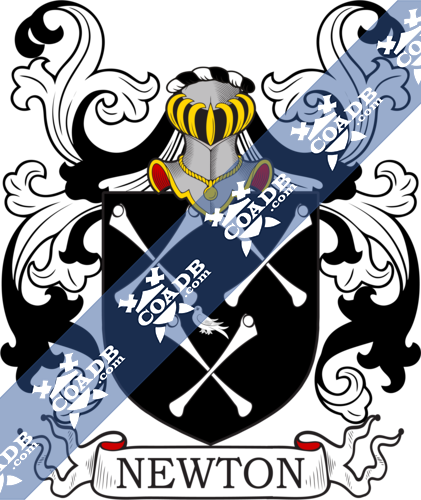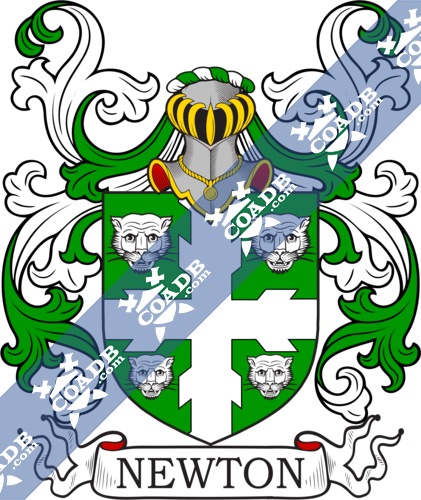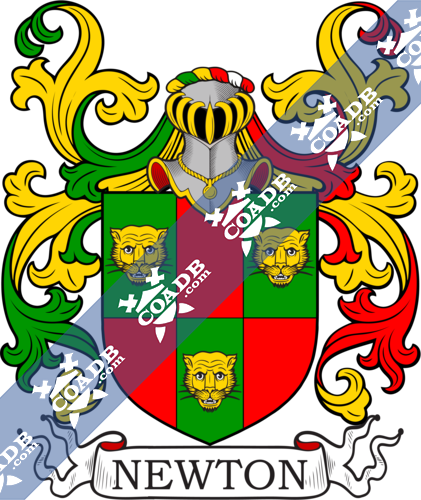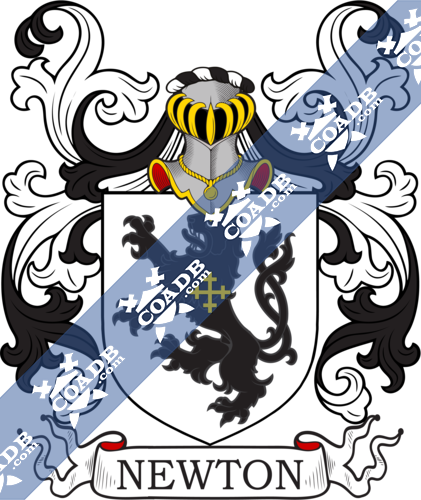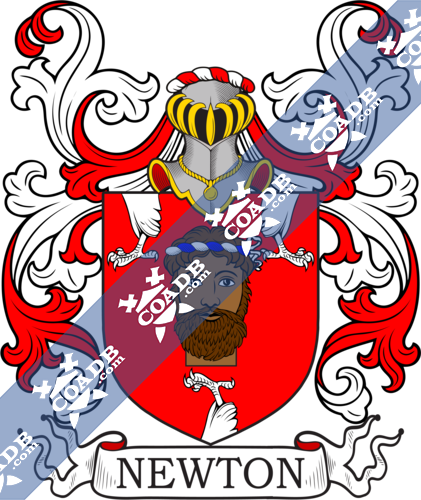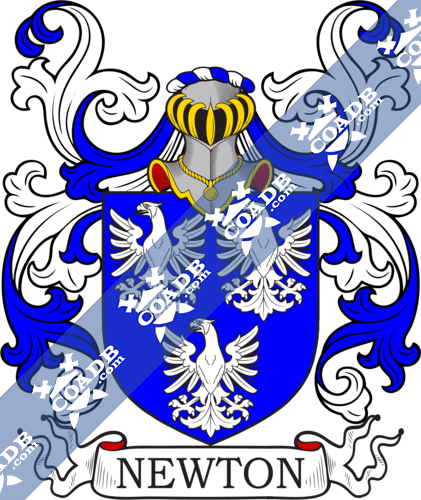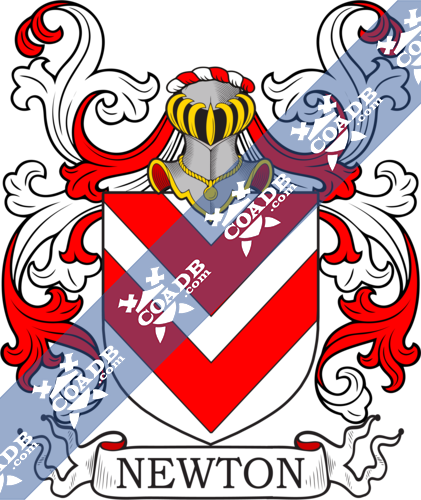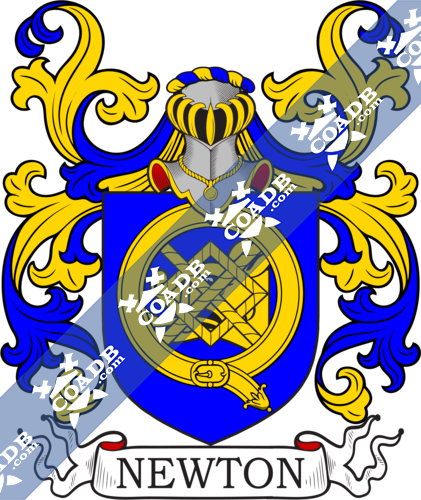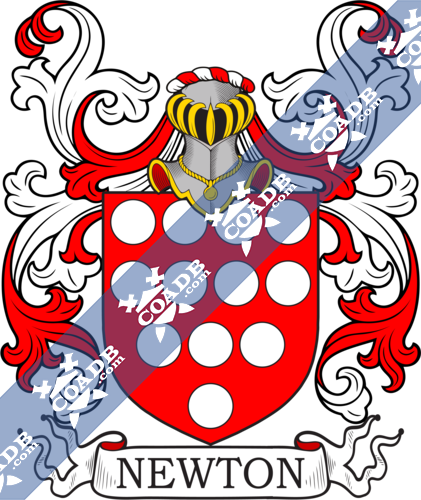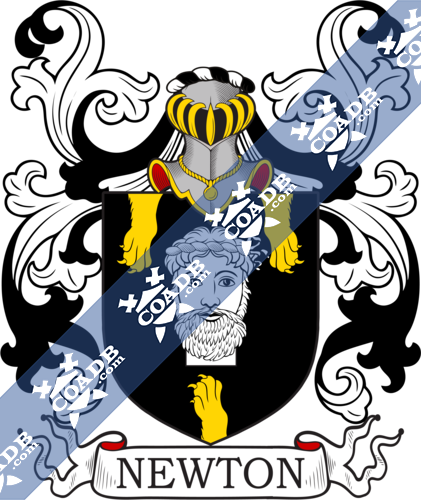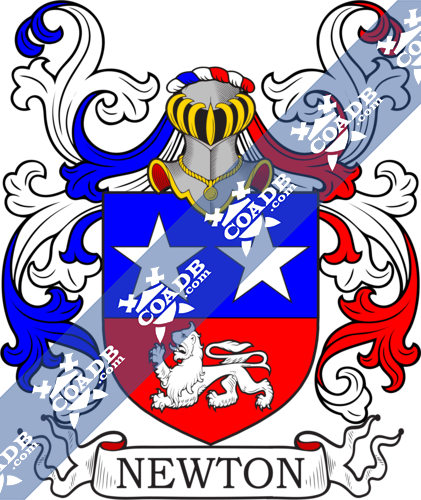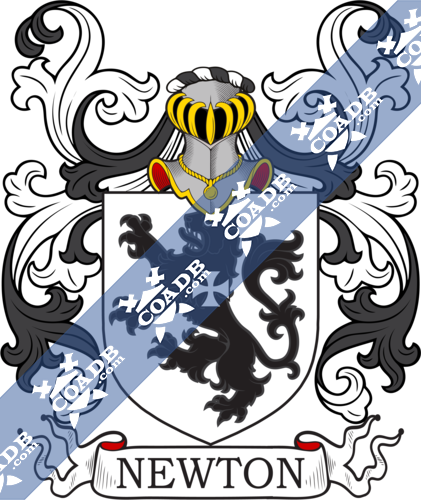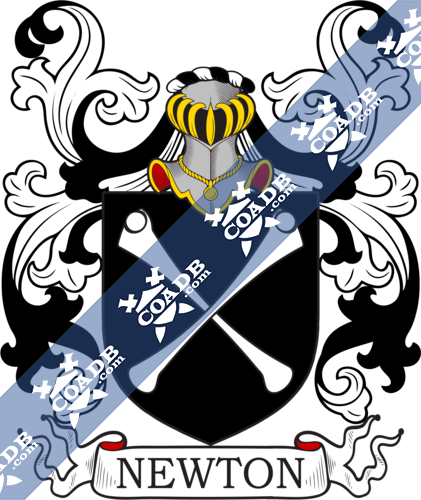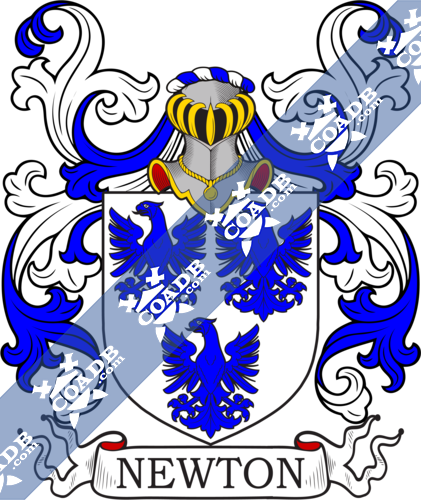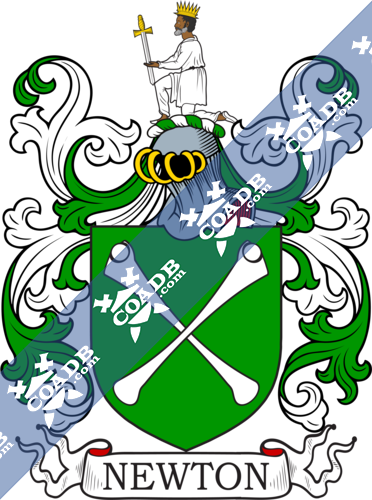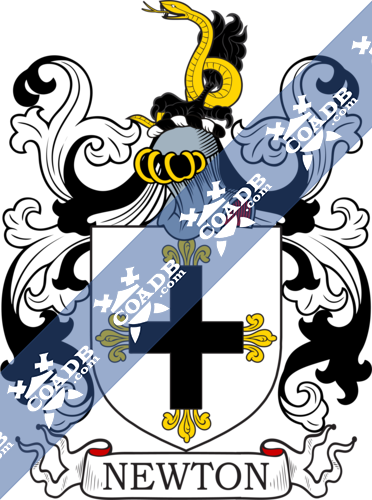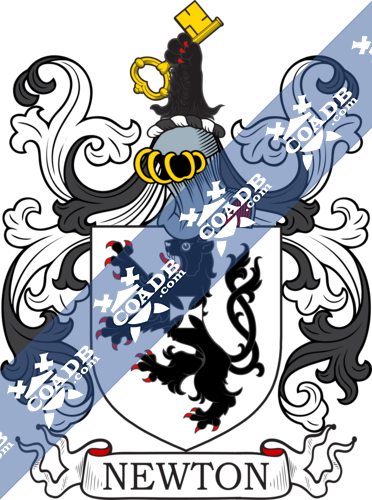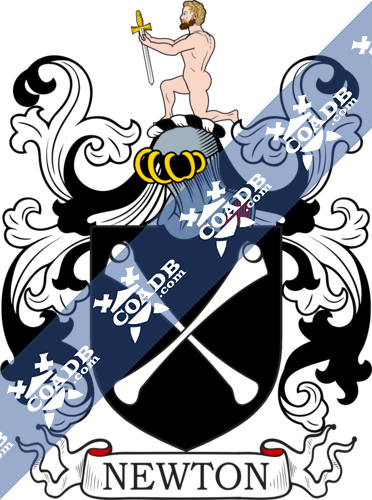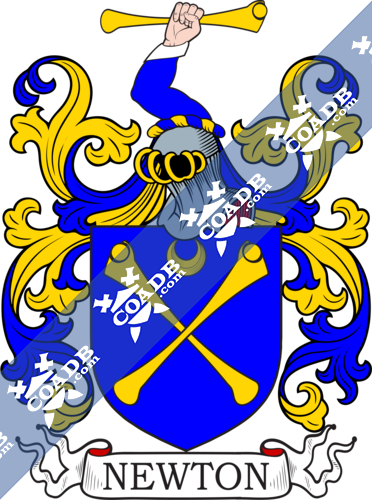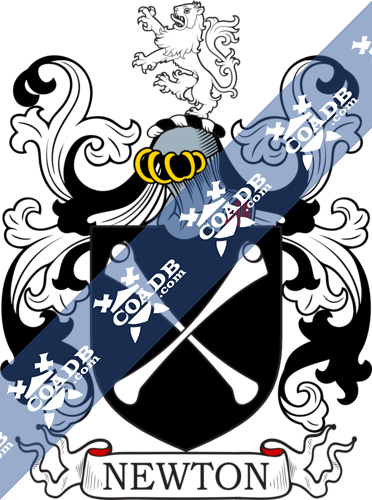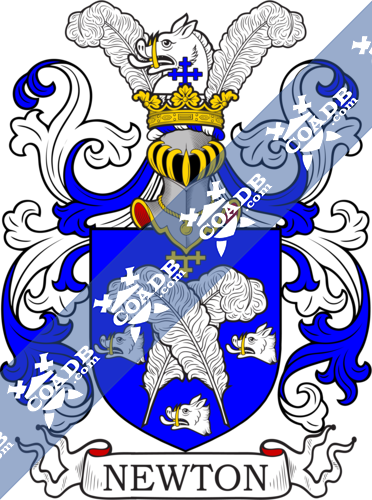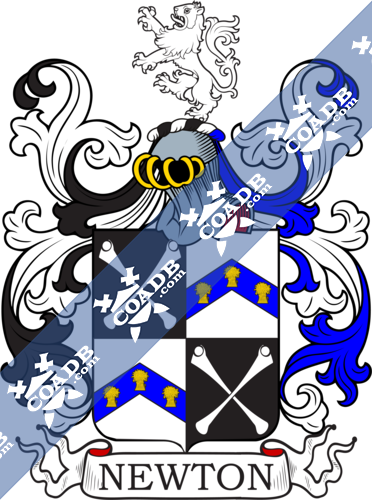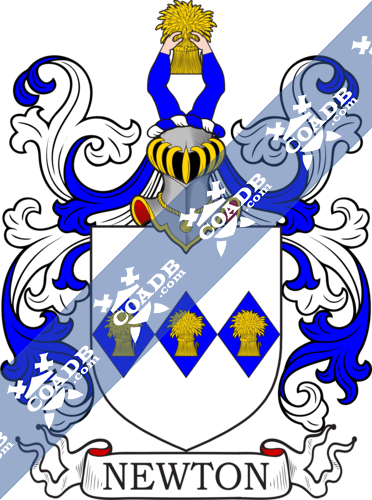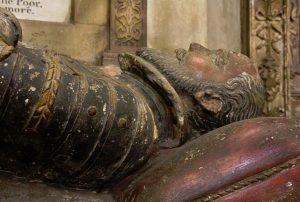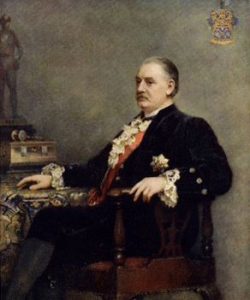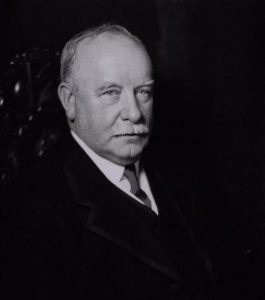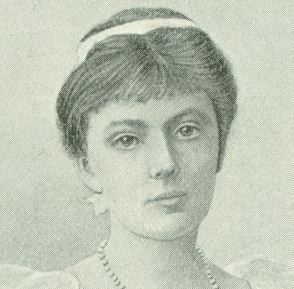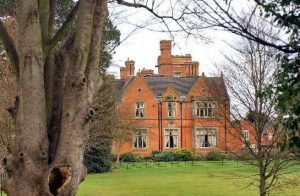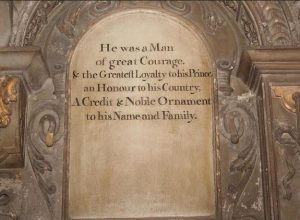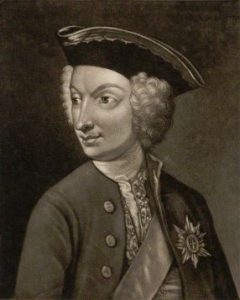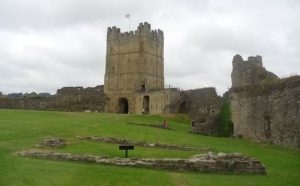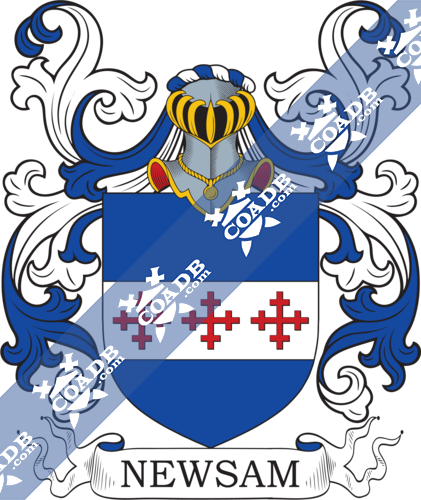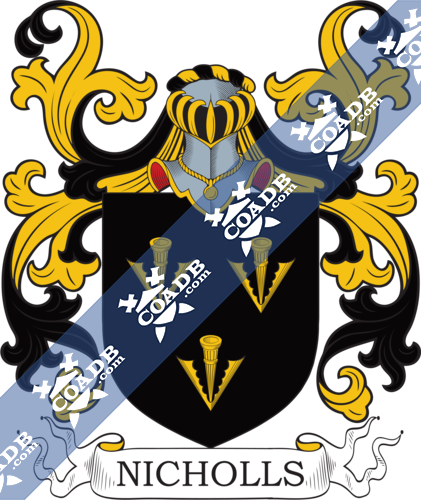Newton Family Crest, Coat of Arms and Name History

Newton Coat of Arms Gallery
Don’t know which Coat of Arms is yours?
We can do a genealogical research. Find out the exact history of your family!
Learn MoreSurname Name Meaning, Origin, and Etymology
This last name is a locational or habitational one meaning “of Newton”, locales in every county in England, as it means “the new town”, in the same way numerous places are named Newham, Newstead, and Oldham. It referred to a dweller at a new farmstead, manor, or estate. It derives from the Old English words neowe (new) and tun (settlement/enclosure). It is the commonest English place name and hence has a fragmented origin. It is remarkable and ironic that many of the oldest places in Britain bear the name New-town. One source states there are at least 90 parishes and townships in Britain bearing this name, and the family pedigree and lineage can be traced to the Newtons of county Chester. There are places named Newnton, Niton, Nauton, and Newington. One source claims the surname was brought into Britain with the Norman Conquest of 1066 AD.
Spelling Variations
Common spelling variants or names with similar etymologies include Neuton, Neutone, Neweton, Newtown, Newtone, and Newtoun.
Popularity & Geographic Distribution
The last name ranks Castle ranks 400th in popularity in terms in the United Status as of the 2000 Census, and. The name ranks particularly high in the following seven eight: Kentucky, Vermont, North Carolina, South Carolina, Alabama, Oklahoma, Arkansas, and Oregon. The name is more common in England where it ranks 174th. It ranks highest in the three following counties: Durham, Cheshire, Derbyshire, Nottinghamshire, Lincolnshire, and Huntingdonshire. The name is common throughout the English speaking world: Scotland (507th), Wales (160th), Ireland (1,985), Canada (725th), New Zealand (238th), Australia (217th), and South Africa (1,226th). In Scotland, the name is more common in Lanarkshire, Midlothian, West Lothian, and Renfrewshire.
The 1890 book Homes of Family Names by H.B. Guppy states “This surname has a disconnected distribution in different parts of England, being nearly always derived from the names of parishes, townships, and other localities in the same county. It is best represented in the northern half of England”.
Early Bearers of the Surname
The first known bearer of this last name was Alward de Niwetuna of Norfolk who was listed in the Domesbay Book of 1086 AD, which was a survey of England and Wales ordered by William the Conqueror. The Hundred Rolls of 1273 AD, a census of Wales and England, known in Latin as Rotuli Hundredorum, documents three people bearing this surname: Gunnora de Neutone in county Suffolk, Ralph de Neutone in county Huntingdonshire, and Alan de Neuton in county Lincolnshire. The Poll Tax of Yorkshire in 1379 AD lists two bearers of this last name: Willelmus de Neweton and Johannes de Neuton. The Register of the University of Oxford for 1579 AD lists one John Newton of county Salop. An early baptism involving this surname was Thomas Newton (son of Thomas) at St. Peter, Cornhill in London in 1683 AD.
History, Genealogy, and Ancestry
The famous genealogist Bernard Burke’s book “The Landed Gentry” discusses five branches of this family: Newton of Mickleover, Newton of Barton Grange, Newton of Croxton Park and Pickhill Hall, Newton of Dunleckney Manor, and Newton of Killymeal.
The first branch begins with a mention of Charles Edmund Newton, Esq. of Mickleover Manor House in County Derby who was born in 1831. He was a Justice of the Peace and in 1855 he married Anne Rosamond, daughter of John Curzon of Breedon, and had five children with her: Robert Curzon (1857), Francis Curzon (1861), Helen Rosamond, Constance Adelaide, and Edith Eleanor. He later married Mary Henrietta, daughter of Captain Moore, and had issue with her: Rosamond Cleere, Mary Leaper, Francis Emily, and Margaret Ethel. Burke traces the lineage or pedigree back to Robert Newton, Esquire of Mickleover in county Derby who was Recorder of the Derby and Barrister-at-Law. He was the son of Robert Newton and Dorothy Lowe. He married Agnes, daughter of Sir Edward Cleere of Ormsby, and had a son with her named Edward. Edward was born in 1610 and in 1625, he married Jane, daughter of John Bereslord. They had a son together named Robert who was born in June 1629. Robert married Elizabeth, daughter of Grevas Whitehead, and had issue with her: Robert, John, Cleere, and Maria. The eldest son and heir was Robert Newton, Esq. of Mickleover who was born in 1670. He married Margaret, daughter of John Wingfield, and had a son with her named Robert. Robert was born in 1713 and was High Sheriff in 1743. He died without an heir and left his estate to a relative: John Leaper, Esq. of Derby who was born in 1754 and was a High Sheriff, D.L., and Justice of the Peace. The Newton family crest has the following heraldic blazon: Sable, two human shin bones in saltire argent, the sinister surmounted of the dexter.
The second branch begins with a mention of Francis Wheat Newton, Esquire of Barton Grange in county Somerset. He was a Justice of the Peace, D.L, and High Sheriff in 1861. He was born in 1814 and attended Pembroke College. In 1849, he married Catherine Bayley, daughter of William Ainslie of Woodhill, and had four children with her: Francis Murray (1852), Arthur Edward (1862), Emily Margaret, and Mary Caroline. He was the son of John Newton and Fanny Margaret (daughter of William Skinner) He succeeded the Barton Grange property upon the death of his cousin, Lady Cooper, daughter of Francis Milner Newton, Esq. of Barton Grange. This branch bore the following Newton Coat of Arms or Newton Family Crest: Argent, a lion rampant tail fourchee sable charged on the shoulder with a cross-pattee of the field.
The third branch begins with a mention of George Onslow Newton, Esq. of Corxton Park in county Cambridge and Pickhill Hall in county Denbigh. He was a Justice of the Peace and D.L. for counties Cambridge and Huntingdon, as well as High Sheriff in 1864 for the former. He was born in 1830 and in 1852 he married Mary, daughter of Wyndham Berkeley Portman of Ham Park. His second wife was Cecilia Florence, daughter of Edwyn Burnaby, and he had two daughters with her: Frances Mary and Cecilia Florence. His third wife was Lady Alice Laura Sophia Cochrane. Burke states this family was founded by Samuel Newton, a merchant living in Liverpool, England who procured lands in North Wales in the early to mid-eighteenth century. His son was named George and George purchased Croxton in county Cambridge in 1820. He married Charlotte, daughter of General Onslow of Staughton House, and had a son with her named George Onslow (mentioned above), as well as two daughters: Emily Charlotte (married Wyndham Berkeley Portman) and Etheldra Julia (married Sir Astley Paston Cooper). This family bore a coat of arms blazoned as follows in heraldry: A chevron between three eagle’s legs erased sable each entwined by a snake or.
The fourth branch begins with a mention of Philip Jocelyn Newton of Dunleckney Manor in county Carlow who was Justice of the Peace, D.L, and High Sheriff in 1846. He was born in 1818 and in 1841 he married Henrietta Maria, daughter of John Kennedy of Dunbrody, and had issue with her: Maria Charlotte, Anne Henrietta (married W.M. Vesey), Adeline Sarah (married Arthur N. Forbes). He later married Emily, daughter of Sir Toler Osborne and had children with her as well: Heriette Phillippa (married Richard Bagwell) and Georginia Emily. Burke states this line originated in Cheshire and accompanied King William III to Ireland in 1688 AD. The first settler, Bartholomew, had a son named John Newton who married Elizabeth, daughter of Francis Lodge, in 1730. This branch had the following Newton Coat of Arms or Newton Family Crest: Azure, two ostrich feathers in saltire between three boars’ heads erased argent tusked or, in the centre chief point a cross-crosslet azure.
The fifth branch begins with a mention of Andrew Willoughby Newton, Esquire of Killymeal House in county Tyrone. He was a Barrister-at-Law who was born in 1849. In 1872, he married Blanche, daughter of John Howard of Sampford Peverell, and had three children with her: Coutenay Howard (1874), Willoughby John, and Annie Adelaide (1877). This family is a branch of the old Cheshire House of Newton. It derived from a member with the first name Rycharde who was Town Clerk of Carrickfergus in 1595. He owned property and had two sons: Richard (Sheriff of Carrickfergus in 1598) and Marmaduke Newton (also Sheriff). Marmaduke had a son named Richard who was an Esquire of Galgorm in county Antrim. This Richard married Margaret, sister of John and Willoughby Chaplin. He had four sons, the eldest named Marmaduke, who became Mayor of Carrickfergus in 1692. He also had a son named Andrew who married his cousin Margaret (daughter of John Chaplin) and had a son with her named Henry. Henry married Sarah, sister of Reverend Joseph Fraser. They had a son named Andrew who was born in 1749. Andrew was of Galgorm and afterwards of Coagh in county Tyrone and he was a Justice of the Peace for counties Tyrone and Londonderry. He married Margaret, daughter of Robert Hamilton of Mintlone, with whom he had the numerous issue. One of his sons was Andrew Newton who was born in 1785 and resided at Dungannon. In 1811, he married Jane, daughter of Joseph Courtenay, and had issue with her, including his heir Courtenay. Courtenay was an Esquire of Killmeal House and was born in 1815. In 1837, he married Frances, daughter of Reverend Thomas Stanley Monck, with whom he had the following children: Andrew Willoughby (mentioned at the beginning of this paragraph), Courtenay, Mary Howard (married Henry Russell Kelly in 1869), and Anna. They bore the following heraldic blazon: Argent, in chief two lion’ gambs erased sable, each grasping a key proper and in base a lion rampant gules charged on the breast with a cross-pattee of the first.
Sir Richard Craycoke or Newton was born in 1398 in Newton, Gloucestershire England, the son of John and Margred verch Hywel. He married a woman named Emat Perret and Emerota Hervery and had five children with her: Thomas, Peter, John, Matthew, and Thomas. His son Thomas Newton was born in 1440 in Wake, England. He in turn had a son named Simon who was born in 1470 is Westby. Simon had a son named John who was born in in 1494 in Westby, Lincolnshire. He married Anne Kellum and had children with her: Thomas, John Newon II, Richard and William. His son John was born in 1530 in the same town. He married Mary Nixe and had three children with her: George, Robert, and Richard. His son Richard Newton (of Woolsthorpe) was born in 1551 and married a woman named Isabel, with whom he had the following issue: Thomas, Robert, Elizabeth, Isaac, Mary, Richard II, and Isabel. His son Isaac was born in 1577 in St. Mary, Essex, England. He married a woman named Thanks and had two issue with her: Isabel and Richard. Richard was born in 1601 in Bures St. Mary England. In 1636 in Sudbury, Massachusetts, he married Anna Hannah Loker and several children with her: Hannah, John Sr., Mary (Johnson), Moses Sr., Exekiel, Joseph Sr., Elizabeth (Dingley), Sarah (Taylor), Hannah, Henry, Daniel, and Isaac. His son Moses was born in 1645 and married Joanna Larkin and later Sarah Joslin. He had the following issue: Andrew, Moses Jr., David, Hannah Bellows, Edward, Jonathan, Jacob, James, Mercy (Leonard), Josiah, and Ebenezer Sr. His son James was born in 1683 in Marlborough, Middlesex, MA. He married Mary Koslin and later Rachel Greeley, leaving behind the following children: Mary, Andrew, Judith, James, Rachel, Jacob, and Joseph. His son Andrew was born in 1713 in the same town and he married Mehitabel Bellows. They had three issue: Mehitable, Andrew, and James. His son Andrew was born in Southborough in 1748 and married Sarah Merrett. They had a son named Shubael born in 1784 in Hopkinton. He married Abigail Pike and they had a daughter named Mary Polly, born in 1812. She married Preserved S. Greene.
Early American and New World Settlers
The book Genealogical Guide to the Early Settlers, mentions ten people bearing this surname: 1) Anthony Newton of Dorchester of Braintree who came in 1640 and later settled in Lancaster, 2) Bryan Newton of Jamaica, Long Island in 1656, 3) Edward Newton of New Haven in 1645, 4) John Newton of Dorchester who came in 1632 and became a freeman the next year. He was a representative of Boston and he had a son named Henry in 1643, 5) Richard Newton of Sudbury who married a woman either named Hannah or Ann and had issue with her including John (1641), Mary (1644), Moses (1646), Jospeh (1655), Elizabeth, Sarah, Isaac, and Hannah. In 1656 he moved to Marlborough (now Southborough) , 6) Roger Newton of Farmington who was a minister who, at Hartford, married Mary, daughter of Thomas Hooker, and had issue Samuel (1646), John (1656), and other children. He also returned to England, 7) Thomas Newton of Fairfield, who was one of the first five settlers, a prominent public figure who was a representative in 1645. He was charged with witchcraft likely, and escaped prison, and took refuge with the Dutch. He lived at Newton in Long Island in 1656, and 8) Thomas Newton recorded in 1688 who came from New Hampshire and was born in 1661. He was controller of the customs at B., judge of the admr. And Attorney-General in the witchcraft prosecution.
Other settlers include: Ellen Newton who came in the Ann or Little James, John Newton who came from the port of London to the Barbados in 1635 aboard the Expedition, George Newton (who owned one slave) lived in the parish of St. Michaells in Barbados in 1680. Other early settlers in colonial America with the surname Newton include Helen (Virginia 1621), Eleanor (Massachusetts 1623), Francis (Virginia 1628), Edward, Henry, & Robert (Virginia 1704), Nathaniel (Virginia 1711), and Anthony (Charleston, 1802).
Mottoes
The Newton family motto is 1) Huic habeo non tibi, meaning “I hold it for him, not for thee”, 2) Faveat fortuna, meaning “Let fortune favour”, and 3) Pro patria, meaning “For my country”.
Grantees
We have 38 coats of arms for the Rodgers surname depicted here. These 38 blazons are from Bernard Burke’s book The General Armory of England, Ireland, and Scotland, which was published in 1848. The bottom of this page contains the blazons, and in many instances contains some historical, geographical, and genealogical about where coat of arms was found and who bore it. People with this last name that had armorial bearing: 1) Houblon-Newton (Susannah?), daughter of John Archer and Lady Mary Fitz-William, [dau. of the 2nd Earl Fitzwilliam], [1818-1819], 2) of Edgefield, co. Norfolk (See Cooper.) Match, [1765], 3) Newton, late Leaper, John, of Derby, [1789], 4) Newton (Jarratt), of Trelawney, Island of Jamaica, [1793], 5) Newton to Frye, of county Surrey. Quarterly Arms, [1801], 6) Newton, Samuel, of Stockport and Cheadle, co. Chester, [1816], 7) Newton to Watson, William, of Wath Cottage, Pickering, and Old Malton, co. York, [1839], 8) Newton, A. H., of Belsize Court, London, 1887, 9) Thomas Henry G., Bar.-at-Law, of Woolton Wawen, co. Warw., 1887, 10) Baron (Legh), of co. Chester. Supporters 1892, and 11) Sir Alfred James, Lord Mayor of London 1899-1900.
Notables
Famous people with this last name include: 1) Sir Isaac Newton (1642-1726) who was a famous astronomer, physicist, and mathematician from England known for developing laws of motion and calculus, 2) John Newton (1725-1807) who was an Anglican clergyman from England who was a captain of slave ships and then became active in the Abolition movement and wrote the song Amazing Grace, one of the most famous church or religious hymns of all time, 3) Nathaniel Newton (1961) who was a football player in the 1980s and 1990s for the Dallas Cowboys in the National Football League, 4) Olivia Newton-John (1948) who is a British-Australia singer and actress best known for starting in the iconic musical Grease in 1978, 5) Carson Wayne Newton (1942) who is a famous American singer and entertainer known for headlining in Las Vegas, and 6) John Newton (1823-1895) who was a General in the Union Army and Chief of the Corps of Engineers during the American Civil War.
Blazons & Genealogy Notes
2) (Horsley and Mickle-Over, co. Derby; descended from Newton, of Newton, co. Chester, settled at Horsley about a.d. 1500. The senior line, Newton, of Duffield, became extinct at the decease of Timothy Newton, Esq., whose heiress m. Hancock, of Brampton; but the male line was continued by Newton, of Mickle-Over, until the death of Robert Newton, of that place, 1789, when the estates and representation of the family devolved on John Leaper, who assumed by sign manual the additional name and arms of Newton). Sa. two human shinbones in saltire the sinister surmounted of the dexter ar. Crest—A naked man kneeling on his sinister knee and holding a sword ppr. the point downward, hilt and pommel or. Motto—Huic habeo tibi.
3) (Duffield, co. Derby, Hadcr, co. Lincoln, and Thorpe, co. York). Sa. two shinbones in saltire, the sinister surmounted of the dexter ar. Crest—A lion ramp. ar. Another Crest—An eastern prince kneeling on the sinister knee, and presenting a sword all ppr.
4) (Barr’s Court, co. Gloucester, bart., extinct 1743, and co. Somerset; descended from Sir Richard Cradock, Chief Justice of England, through his second son. Sir Thomas Newton, temp. Edward IV.; his descendant, Sir John Newton, of Barr’s Court, was created a baronet in 1660). Quarterly, 1st and 4th, sa. two shinbones saltireways, the sinister surmounted, of the dexter ar., for Newton; 2nd and 3rd, ar. on a chev. az. three garbs or, for Cradock. Crest—Same as Newton, of Duffield.
5) (Newton co. Chester). Vert a ton or; sometimes, Ar. a lion ramp. sa. charged on the shoulder with a cross pattée or. Crest—A lion’s gamb sa. holding a key or, to which is a chain dependent, fastened to a ring of the last.
6) (Cheadle Heath, co. Chester; descended from Newton, of Newton). Gu. a cross erm. flory or, betw. four lions’ gambs of the last. Crest—A lion ramp. per fesse erm. and gu. collared also gu. holding betw. the paws a cross, as in the arms. Motto—Faveat fortuna.
7) (Badenham, co. Bedford, Lavendon, co. Buckingham, and Exmouth, co. Devon). Ar. three lozenges conjoined in fesse az. each charged with a garb or. Crest—Two arms counter-embowed dexter and sinister, vested az. holding up in the hands ppr. a garb or.
8) (co. Cambridge). Sa. two shinbones in saltire, the dexter surmounted of the sinister ar.
9) (co. Chester). Ar. three eagles displ. az.
10) (cos. Chester, Gloucester, Norfolk, and Somerset; Sir John Newton, Knt., of Harptre, in the latter co., 1567). Ar. on a chev. az. three garbs or.
11) (co. Oxford). Ar. a lion ramp. double queued sa. armed and langued gu.
12) (Highley, co. Salop). Ar. a cross flory sa. the ends or. Crest—An eagle’s leg erased at the thigh sa. environed with a snake or.
13) (Bagdale Hull, co. York). Sa. three pairs of shinbones in saltire ar. a martlet for diff.
14) (co. Durham. Visit. 1615). Az. on a chev. or, three garbs sa.
15) (co. Essex). Sa. a bend sinister surmounted of another dexter or (another, ar.).
16) (Charlton, co. Kent, and Priory, co. Warwick, bart., extinct 1700). Az. two ostrich feathers in saltire betw. three boars’ heads couped at the neck ar. bristled and tusked or. Crest—Out of a ducal coronet or, a boar’s head betw. two ostrich feathers ar.
17) (Next Trent, co. Lincoln; granted 14 June, 1660). Vert a cross ragulée betw. four leopards’ faces ar.
18) (London, cos. Somerset, Suffolk, Sussex, and Wilts). Ar. a lion ramp. sa. armed gu. tail double queued, charged on the shoulder with a cross pattée of the field. Crest—A lion’s gamb erect holding a key or.
19) Ar. a lion ramp. double queued sa. gorged with a chaplet or. Crest—A lion’s gamb erect gu. grasping a key affixed to a chain or.
20) (Newcastle-on-Tyne). Az, two shinbones in saltire, the sinister surmounted of the dexter or, a crescent for diff. Crest—An arm embowed, habited, holding a shinbone.
21) (co. Salop). Per fesse vert and gu. a pale counterchanged, three leopards’ faces or.
22) (co. Suffolk). Ar. a lion ramp. tail double queued sa. on the shoulder a cross crosslet or.
23) (co. Sussex, 1633). Gu. a Saracen’s head couped at the neck ppr. wreathed round the temples ar. and az. betw. three, eagles’ claws issuing out of the three points of the escutcheon ar.
24) (Richmond Castle, co. Somerset; granted 12 Dec. 10 Elizabeth). Ar. on a chev. az. three garbs or, quartering Cradock, alias Newton, Sherborne, Angell, Pirot, Harvy, Shedder, Hampton, Bittpon, Furneaux, Gawdescot, Gurney, and Hawtrey.
25) (Croxton Park, co. Cambridge). A chev. sa. betw. three eagles’ legs erased, each entwined by a snake. Crest—an eagle’s leg erased entwined by a snake.
26) Az. three eagles displ. ar.
27) Ar. two chev. reversed gu.
28) Az. a boar’s head couped, surmounted by a knot within a garter all or.
29) Gu. twelve plates, four, four, three, and one.
30) Vert a lion ramp. or, armed and langued gu.
31) Ar. fretty az. on a fess gu. three mullets or.
32) Ar. on a chev. az. three garbs or. Crest—A bear’s head couped ar. muzzled gu.
33) (Reg. Ulster’s Office; descended out of co. York). Sa. a Saracen’s head couped at the neck ar. betw. three lion’s gambs issuant from the dexter chief, sinister chief, and base points or.
34) (Carrickfergus, co. Antrim; confirmed to Andrew Newton, Esq., of Dungannon, co. Tyrone, descended from Richard Newton, who settled at Carrickfcrgus before 1595). (Hillmount, co. Londonderry). Ar. in chief two lions’ gambs sa. each grasping a key ppr. and in base a lion ramp. gu. charged on the breast with a cross pattée of the field. Crest—A martlet sa. charged on the breast with a cross pattee ar. Motto—Faveat fortuna.
35) (Dunleckney, co. Carlow; confirmed to Philip Jocelyn Newton, Esq., of Dunleckncy, and the descendants of his grandfather). Az. two ostrich feathers in saltire betw. three boars’ heads erased, two in fess and one in base ar. tusked or, and in the centre chief point a cross crosslet of the last. Crest—Out of a ducal coronet or, a boar’s head betw. two ostrich feathers ar. the ncck charged with a cross crosslet az. Motto—Pro patria.
36) (Newton, co. Haddington). The last male heir, Sir Richard Newton, Bart., of Newton, settled his estate, by entail dated 18 June, 1724, on Richard Hay, fourth son of Lord William Hay). Vert a lion ramp. or, on a chief of the last three roses gu. Crest—A demi lion or, holding in the dexter paw a scymitar all ppr. Motto—Pro patria. The old arms of the family seem to have been, Ar. three boars’ heads couped az. Old arms of the family seem to have been, Ar. three boars’ heads couped az.
37) (Dalcoif, co. Berwick). Per fesse az. and gu. on the first two stars, on the second a lion pass. ar.
38) (Compton-Deverell. and Swell, co. Somerset; John Newton, of Compton, temp. James I., son of Edward Newton, of Swell, and grandson of Thomas Newton, of same place, who was great-grandson of William Newton and Idonea Montagu, his wife. Visit. Somerset, 1623). Ar. a lion ramp. sa. charged on the shoulder with a cross pattee of the field.


